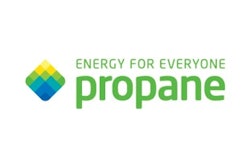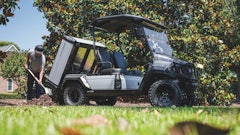
Gas, battery, propane—which is the best to power equipment?
In order to help landscape contractors puzzle out which power source is best for their business, here’s a rundown of the best applications for gas, battery and propane power.
Gas
In certain situations, gas power still makes sense for landscape contractors, especially when taking into consideration run time and available charging infrastructure.
For example, construction, commercial and industrial applications still rely heavily on gas-powered equipment, according to David Bush, assistant manager, shows, events and sponsorships, Honda Power Sports & Products.
“Anything that requires a fairly long run time and where there’s a heavy load application, the battery product may have a tendency to not last as long,” Bush says. “Unless there’s a need for quietness or restrictions from an emissions standpoint, the gasoline-powered engine is an advantage here.”
Additionally, electronic fuel injection (EFI) has improved starting ability and fuel efficiency, according to Bush.
“EFI lends itself to (addressing) performance issues but also fuel efficiency, which is always a top line consideration for any power equipment, especially on the commercial side,” Bush says. “So, our core engine product hasn’t had huge changes, but with the introduction of EFI, it’s changing and evolving.”
Additional items to keep in mind:
- Consider the price of buying gas
- State and local regulations that may limit gas-powered equipment
Battery
As more suppliers enter the market and lead-acid batteries are replaced with lithium-ion batteries, battery power has experienced improvements in cell technology, says Nick Moore, director of product management, electrification, Briggs & Stratton.
“It appears that most equipment OEMs realize they have to have a lithium offering now, but we are all still feeling our way through understanding exactly what the end users want and need,” Moore says. “The hard part with converting an engine to battery is determining the battery size, which will equate to run time. Too little, and customers can be disappointed; too much, and the machine can be prohibitively expensive, so it’s about finding the sweet spot.”
Moore notes that performance, battery life and run times will only continue to improve, alleviating some hesitation among end users.
Some of the best applications are not only ones that require reduced exhaust and noise emissions, but also ones that seek to solve other problems for the end user such as allowing historically outdoor only machines to be used indoors, or in confined spaces, keeping users healthy.
“As emission regulations and municipality requirements continue to evolve, that will ultimately drive the transition from gas power to battery power,” Moore says. “Within the U.S., we see the regions that are on the front line of emissions reductions driving demand. Corporations, municipalities and universities driving ESG initiatives also are pulling product through. The EU overall is also driving demand, and in many cases, with the smaller machines, this makes the switch easier."
Additional items to consider:
- Understand the full power system and how all components work together.
- Consider the charging infrastructure and run time of batteries.
Propane
When it comes to propane to power equipment, it can be used in two ways: as a standalone product or paired with a battery-powered product, according to Mike Newland, director of agriculture business development at the Propane Education & Research Council (PERC).
Newland says contractors have been using propane as a standalone option for some time, but for sites where the charging infrastructure is not in place, vendors have created EV chargers that are powered by propane.
Applications for propane include those where battery run time is an obstacle or where gasoline or diesel small engines may be banned due to their emissions profile. Additionally, propane is “cleaner energy” than battery power in cases where the electric grid is powered by coal.
“Propane also allows contractors to be productive on those days in summer when contractors really need to pay attention to their emissions,” Newland says.
Finally, Newland notes that renewable propane has come to the scene in recent years. Made from nonpetroleum feedstocks, it’s chemically identical to conventional propane and can be used as a drop-in replacement fuel.
“It’s important because it has roughly half the carbon intensity of conventional propane, so we think that market is going to grow and pick up pace,” Newland says. “In the industry, especially where commercial cutters are paying attention to their customers’ wishes for a lower carbon footprint, we think it’s going to be a big deal.”
Additional items to keep in mind:
- Ensure you have a strong relationship with your propane supplier.
- Determine how many gallons you will need.
















![Gravely Pro Turn Mach One My23 Dsc03139 Edit 1200x800 5b2df79[1]](https://img.greenindustrypros.com/mindful/acbm/workspaces/default/uploads/2025/10/gravely-pro-turn-mach-one-my23-dsc03139-edit-1200x800-5b2df791.BucBnDoN22.jpg?ar=16%3A9&auto=format%2Ccompress&fit=crop&h=135&q=70&w=240)



